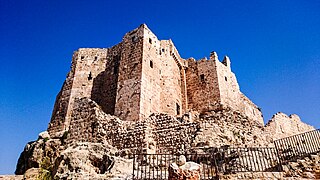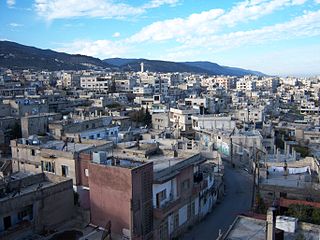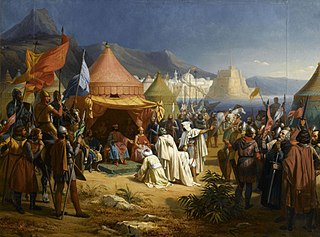
The Order of Assassins or simply the Assassins were a Nizari Isma'ili order that existed between 1090 and 1275 AD, founded by Hasan-i Sabbah.

The Alawites, also known as Nusayrites, are an ethnoreligious group that live primarily in the Levant and follow Alawism, a religious sect that splintered from early Shi'ism as a ghulat branch during the ninth century. Alawites venerate Ali ibn Abi Talib, revered as the first Imam in the Twelver school, as the physical manifestation of God. The group was founded by Ibn Nusayr during the 9th century. Ibn Nusayr was a disciple of the tenth Twelver Imam, Ali al-Hadi and of the eleventh Twelver Imam, Hasan al-Askari. For this reason, Alawites are also called Nusayris.
Ridwan was a Seljuk emir of Aleppo from 1095 until his death.

Margat, also known as Marqab, is a castle near Baniyas, Syria, which was a Crusader fortress and one of the major strongholds of the Knights Hospitaller. It is located around 2 kilometres (1.2 mi) from the Mediterranean coast and approximately 6 kilometres (3.7 mi) south of Baniyas. The castle remained in a poor state of preservation until 2007 when some reconstruction and renovation began.

Masyaf is a city in northwestern Syria. It is the center of the Masyaf District in the Hama Governorate. As of 2004, Masyaf had a religiously diverse population of approximately 22,000 Ismailis, Alawites and Christians. The city is well known for its large medieval castle, particularly its role as the headquarters of the Nizari Ismailis and their elite Assassins unit.

The siege of Tripoli lasted from 1102 until 12 July 1109. It took place on the site of the present day Lebanese city of Tripoli, in the aftermath of the First Crusade. It led to the establishment of the fourth crusader state, the County of Tripoli.

The Ma'n dynasty, also known as the Ma'nids;, were a family of Druze chiefs of Arab stock based in the rugged Chouf area of southern Mount Lebanon who were politically prominent in the 15th–17th centuries. Traditional Lebanese histories date the family's arrival in the Chouf to the 12th century, when they were held to have struggled against the Crusader lords of Beirut and of Sidon alongside their Druze allies, the Tanukh Buhturids. They may have been part of a wider movement by the Muslim rulers of Damascus to settle militarized Arab tribesmen in Mount Lebanon as a buffer against the Crusader strongholds along the Levantine coast. Fakhr al-Din I, the first member of the family whose historicity is certain, was the "emir of the Chouf", according to contemporary sources and, despite the non-use of mosques by the Druze, founded the Fakhreddine Mosque in the family's stronghold of Deir al-Qamar.
Al-Qadmus is a town in northwestern Syria, administratively part of the Tartus Governorate, located northeast of Tartus and 14 kilometres southeast of Baniyas. Nearby localities include Kaff al-Jaa and Masyaf to the east, Wadi al-'Uyun and al-Shaykh Badr to the south, Hammam Wasel, al-Qamsiyah and Maten al-Sahel to the southwest, Taanita to the west, al-Annazeh to the northwest and Deir Mama to the northeast. It is situated just east of the Mediterranean coast and its ruined castle stands on a plateau roughly 850 metres above sea level and just above the town.

Al-Kahf Castle or the Castle of the Cave is a medieval Nizari Isma'ili castle located around 30 kilometres (19 mi) southeast of Margat, in the al-Ansariyah mountains in northwest Syria.

Abu Qubays is a former medieval castle and currently an inhabited village in northwestern Syria, administratively part of the Hama Governorate, located northwest of Hama. It is situated in the al-Ghab plain, west of the Orontes River. Nearby localities include Daliyah 21 kilometers to the west, al-Laqbah to the south, Deir Shamil to the southeast, Tell Salhab to the northeast and Nahr al-Bared further northeast. According to the Syria Central Bureau of Statistics (CBS), Abu Qubays had a population of 758 in the 2004 census. Its inhabitants are predominantly Alawites.

The Nizari state was a Nizari Isma'ili Shia state founded by Hassan-i Sabbah after he took control of the Alamut Castle in 1090 AD, which marked the beginning of an era of Ismailism known as the "Alamut period". Their people were also known as the Assassins or Hashashins.
Gibelacar, also known by its original Arabic name Hisn Ibn Akkar or its modern Arabic name Qal'at Akkar, is a fortress in the village of Akkar al-Atiqa in the Akkar Governorate in northern Lebanon. The fortress dates back to the Fatimid era in the early 11th century. It was captured and utilized by the Crusaders in the early 12th century until it was captured and strengthened by the Mamluks in the late 13th century. It became the headquarters of the Sayfa clan, whose members, chief among them Yusuf Pasha, served as the governors and tax farmers of the Tripoli Eyalet and its sanjaks from 1579 through the mid-17th century.
Abū Muḥammad al-Ḥasan ibn Yūsuf al-Makzūn al-Sinjārī, better known simply as al-Makzun al-Sinjari, was a paramount military, religious and literary figure in Alawite history and tradition. Al-Makzun was well-educated in Arabic poetry and Shia Islam. Descended from a line of emirs of Sinjar, he succeeded his father as emir of the town in 1205. Many Alawites from Sinjar migrated to the mountains around Latakia during the time of his father. The Alawites of these mountains later appealed for al-Makzun's intervention amid their struggles with the Kurds and Nizari Ismailis. Al-Makzun led an expedition to relieve the Alawites after many were massacred in the Sahyun fortress. Between 1218 and 1222, he and his sons captured the forts of Abu Qubays, which became al-Makzun's seat of power, al-Marqab, al-Ulayqa and Baarin. He ultimately drove out most of the Kurds and Ismailis from the mountains, consolidating the Alawite presence. In the following years, he penned a number of Alawite religious books.
By the late 11th century, the Shi'a sub-sect of Ismailism had found many adherents in Persia, although the region was occupied by the Sunni Seljuk Empire. The hostile tendencies of the Abbasid–Seljuk order triggered a revolt by Ismailis in Persia under Hassan-i Sabbah. Siege of Maysaf
The Banu Munqidh, also referred to as the Munqidhites, were an Arab family that ruled an emirate in the Orontes Valley in northern Syria from the mid-11th century until the family's demise in an earthquake in 1157. The emirate was initially based in Kafartab before the Banu Munqidh took over the fortress of Shayzar in 1081 and made it their headquarters for the remainder of their rule. The capture of Shayzar was the culmination of a long, drawn-out process beginning with the Banu Munqidh's nominal assignment to the land by the Mirdasid emir of Aleppo in 1025, and accelerating with the weakened grip of Byzantine rule in northern Syria in the 1070s.
Irtash was a Seljuk emir of Damascus in 1104. Irtash was born to Taj ad-Dawla Tutush, the brother of the Seljuk Sultan Malik-Shah I who established a principality in Syria after his brother gave the region and the adjacent areas to him. Following the death of Malik-Shah, Tutush claimed the Seljuk crown, but he was killed by the forces of his nephew Berkyaruq near Ray. Subsequently, Irtash's brother Ridwan moved to Aleppo and proclaimed himself the new emir. Irtash's other brother Duqaq's declaration of a new emirate in Damascus separated the Syrian Seljuk state into two and started a rivalry between the two brothers. Duqaq then imprisoned Irtash for nine years in Baalbek.
The Banu Ammar were a family of Shia Muslim magistrates (qadis) who ruled the city of Tripoli in what is now Lebanon from c.1065 until 1109.
The Buhturids, also known as the Banu Buhtur or the Tanukh, were a dynasty whose chiefs were the emirs of the Gharb area southeast of Beirut in Mount Lebanon in the 12th–15th centuries. A family of the Tanukhid tribal confederation, they were established in the Gharb by the Muslim atabegs of Damascus after the capture of Beirut by the Crusaders in 1110. They were tasked with guarding the mountainous frontier between the Crusader coastlands and the Islamic interior of the Levant. They were granted iqtas over villages in the Gharb and command over its peasant warriors, who subscribed to the Druze religion, which the Buhturids followed. Their iqtas were successively confirmed, decreased or increased by the Burid, Zengid, Ayyubid and Mamluk rulers of Damascus in return for military service and intelligence gathering in the war with the Crusader lordships of Beirut and Sidon. In times of peace the Buhturids maintained working relations with the Crusaders.
Maniqa is a castle located in the Syrian Coastal Mountain Range, dated back to the Roman era, it was also known as "Malikas" or "Malghanes" during the Crusader rule.

Fakhr al-Mulk ibn Ammar was the last qadi of Tripoli, from 1099 to 1109, before the city was taken by the Crusaders.









